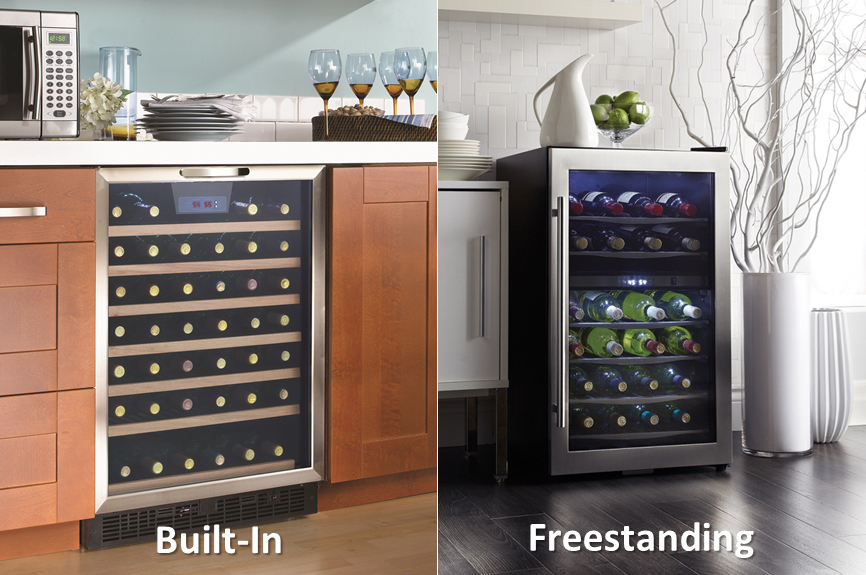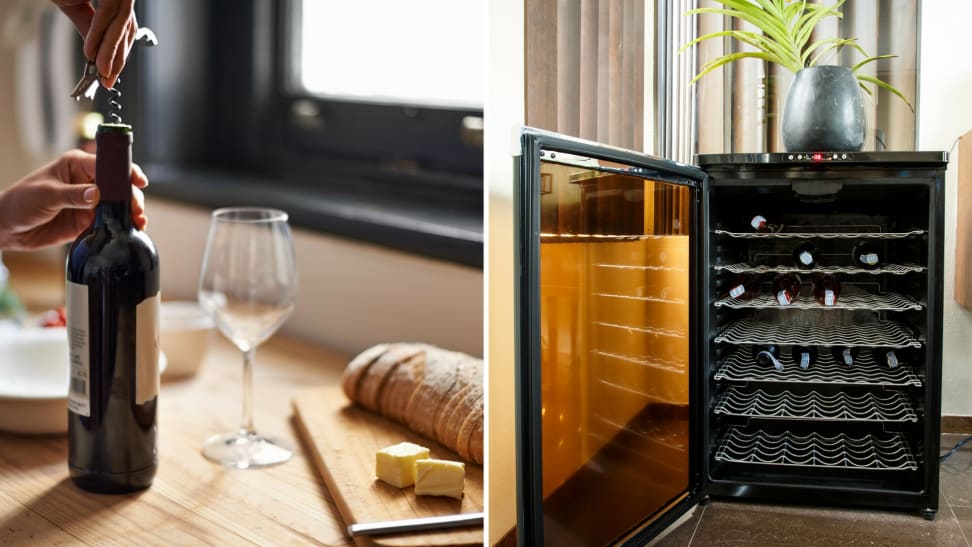Are you curious about the differences between a wine fridge and a regular fridge? Well, you’re in the right place! In this article, we’ll explore the unique features and benefits that set a wine fridge apart from a traditional refrigerator. Whether you’re a wine enthusiast or simply interested in learning more, we’ll provide you with all the information you need to understand the distinct qualities of a wine fridge. So, let’s dive in and discover what makes these specialized appliances so special!
If you’ve ever wondered why wine lovers choose to invest in a wine fridge, you’re about to find out. In this article, we’ll delve into the specific factors that make a wine fridge different from a regular refrigerator. From temperature control and humidity levels to storage capacity and design, we’ll cover it all. Whether you’re looking to store a few bottles or create a dedicated wine cellar, understanding the unique features of a wine fridge will help you make an informed decision. So, if you’re ready to learn more about the fascinating world of wine fridges, keep reading!

Temperature Control
Wine fridge’s specific temperature control
When it comes to temperature control, wine fridges have an advantage over regular fridges. Wine enthusiasts know that the ideal temperature for storing wine is between 45 and 65 degrees Fahrenheit. Wine fridges are specifically designed to maintain this temperature range consistently, providing the perfect environment for wine storage.
Unlike regular fridges that have a general temperature control system, wine fridges offer more precise temperature settings. This is crucial for wine preservation, as even slight temperature fluctuations can impact the taste and aroma of the wine. With a wine fridge, you can set the temperature to your desired level and trust that it will remain constant, ensuring that your wine ages gracefully.
Regular fridge’s general temperature control
Regular fridges, on the other hand, are not designed with wine storage in mind. They are typically set to a colder temperature range to keep food fresh and prevent spoilage. While they can keep wine cool, they may not provide the same level of temperature control as wine fridges.
In a regular fridge, the temperature can fluctuate more due to frequent opening and closing of the door as well as the placement of various food items. This inconsistency in temperature can affect the quality of the wine stored in a regular fridge, especially if it is being stored for an extended period.
Humidity Levels
Wine fridge’s controlled humidity levels
Humidity is another vital factor in wine storage. Wine requires a specific humidity level to prevent the corks from drying out, which can lead to oxidation and spoilage. Wine fridges are designed to maintain a controlled humidity level of around 50-80%. This ensures that the corks remain moist and the wine is protected from external moisture.
Wine fridges often come with humidity control features to maintain the optimum level. This is particularly important for long-term storage, as it ensures the wine’s quality and aging process are not compromised by dry corks.
Regular fridge’s natural humidity levels
Regular fridges, while they do have some measure of humidity control, are not designed to maintain specific humidity levels. They rely on natural humidity levels within the environment, which can vary depending on factors such as the weather and the contents of the fridge.
These natural humidity levels may not be ideal for wine storage and can contribute to the deterioration of the quality of the wine over time. Additionally, regular fridges may not have features to prevent excessive moisture, potentially leading to mold growth in certain cases.
Shelving and Storage
Wine fridge’s specialized shelving for wine bottles
Wine fridges come equipped with specialized shelving designed to accommodate wine bottles. These shelves are typically made of wood or metal, with individual slots or racks to securely hold each bottle. The shelves are designed to minimize vibrations and allow proper air circulation around each bottle.
The design of wine fridge shelves also takes into consideration the varying sizes and shapes of wine bottles. Some shelves are adjustable or removable, allowing for customization and flexibility in storage options.
Regular fridge’s adjustable shelves for various items
Regular fridges, while not specifically designed for wine storage, offer adjustable shelves that can accommodate various items, including wine bottles. These shelves are typically made of glass or plastic and can be rearranged to create more space or accommodate larger items.
However, the design and construction of regular fridge shelves may not prioritize wine preservation. They may not provide the same level of stability and vibration reduction as wine fridge shelves do. This can lead to movement and potential damage to the wine bottles stored in a regular fridge.
Vibration
Wine fridge’s reduced vibration for wine preservation
Vibration can have a detrimental effect on wine aging. It can disturb the sediments in the wine, affecting its flavor and clarity. Wine fridges are designed to minimize vibrations to protect the delicate structure of the wine.
Wine fridges often come equipped with features such as rubberized feet or special shock-absorbing systems to reduce vibrations. These features ensure that the wine remains undisturbed, allowing it to age gracefully and maintain its intended qualities.
Regular fridge’s standard vibration levels
Regular fridges are not specifically designed to reduce vibrations. They may have standard motor and compressor systems that can generate vibrations during operation. While these vibrations may not be significant enough to cause immediate damage to wine, they can have a cumulative effect over time, leading to subtle changes in the wine’s taste and aroma.
If you are storing wine in a regular fridge, it is advisable to place the bottles in an area where they are less likely to experience constant movement or jostling.

Lighting
Wine fridge’s dim lighting to minimize wine degradation
Exposure to light can be harmful to wine. Ultraviolet (UV) rays, in particular, can cause the wine to age prematurely, leading to a degradation in flavor and color. Wine fridges are designed with this in mind and often feature dim or UV-resistant lighting.
The dim lighting in wine fridges provides sufficient illumination for visibility without compromising the wine’s quality. It helps to create a dark and controlled environment, protecting the wine from the damaging effects of light.
Regular fridge’s bright lighting for visibility
Regular fridges typically have bright lighting to ensure visibility when accessing food items. While this is convenient for everyday use, it can be detrimental to wine storage.
The bright lighting in regular fridges can expose the wine bottles to harmful UV rays, accelerating the aging process. If you need to store wine in a regular fridge, it is advisable to place the bottles away from direct light or wrap them in protective covers to reduce the exposure.
Door Design
Wine fridge’s UV-resistant and insulated glass door
The door design of wine fridges is specifically engineered to protect wine bottles from external factors. Wine fridges often feature UV-resistant glass doors that block harmful rays from entering the fridge. This helps to maintain a stable and consistent environment for the wine.
Additionally, wine fridge doors are well-insulated to prevent temperature fluctuations. The insulation ensures that the temperature inside the fridge remains constant, further safeguarding the wine’s quality.
Regular fridge’s standard door design
Regular fridges typically have standard doors that may not provide the same level of protection as wine fridge doors. While they can keep the contents of the fridge cool, they may not offer the same insulation or UV resistance as wine fridge doors.
This can result in temperature fluctuations and light exposure that can compromise the quality of the wine stored in a regular fridge.

Capacity
Wine fridge’s smaller capacity for wine storage
Wine fridges are designed with wine enthusiasts in mind. They often have smaller capacities specifically tailored for wine bottles. This allows for efficient organization and storage of wine collections without taking up excessive space.
The smaller capacity of wine fridges also helps in maintaining a constant temperature and humidity level, as the fridge doesn’t have to work as hard to cool or dehumidify a large space.
Regular fridge’s larger capacity for general storage
Regular fridges, being intended for general use, have larger capacities to accommodate a wide variety of food items. They are designed to provide ample storage space for everyday groceries and household needs.
While regular fridges can store wine bottles, the larger capacity and lack of specific wine storage features may not provide the same level of protection and organization as a wine fridge.
Air Circulation
Wine fridge’s optimized air circulation for even cooling
Proper air circulation is essential for maintaining a consistent temperature and humidity within a wine fridge. Wine fridges are designed with optimized air circulation systems that ensure even cooling throughout the unit.
These systems prevent hot or cold spots within the fridge, eliminating temperature differentials that can affect the quality of the wine. The consistent airflow also helps in maintaining a stable humidity level, preventing excess moisture or dryness.
Regular fridge’s standard air circulation
Regular fridges have standard air circulation systems that are primarily focused on cooling food items. While they do provide some level of air circulation, it may not be as optimized for wine storage as in wine fridges.
The airflow in regular fridges can be affected by the placement of different food items, resulting in uneven temperature distribution. This can potentially impact the quality of wine stored in the fridge.

Noise Levels
Wine fridge’s quieter operation for wine aging process
For the optimal aging process of wine, minimal disruption is key. Wine fridges are designed to operate quietly, with noise levels kept to a minimum.
The reduced noise levels in wine fridges ensure that the wine can age undisturbed by the humming or vibrations caused by the fridge’s operation. This is particularly important for wines that require long-term storage and maturation.
Regular fridge’s normal noise levels
Regular fridges, while not specifically designed for wine storage, operate at normal noise levels. The compressors and fans in regular fridges can generate a certain level of noise during operation.
While these noise levels may not be disruptive to everyday use, they may impact the aging process of wine, especially for sensitive varietals that require a quiet environment.
Conclusion
In conclusion, a wine fridge differs from a regular fridge in several key aspects. Wine fridges offer specific temperature control, controlled humidity levels, specialized shelving for wine bottles, reduced vibration, dim lighting, UV-resistant and insulated glass doors, a smaller capacity for wine storage, optimized air circulation, and quieter operation. These features are tailored to create the perfect environment for wine storage, ensuring that your beloved bottles age gracefully and maintain their quality over time. While a regular fridge can serve as a temporary storage option for wine, investing in a wine fridge is highly recommended for wine enthusiasts who want to preserve and enjoy their collection to the fullest. So whether you’re a casual wine drinker or a serious connoisseur, a wine fridge should be on your radar for optimum wine storage and enjoyment.

